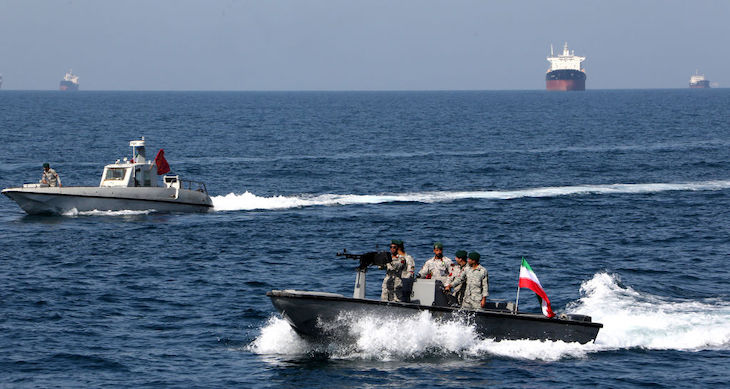Nato has learned nothing from Russia’s energy blackmail – and Iran is about to prove it. With precision warheads and hypersonic payloads tearing Israeli and Iranian skies, you might think we’re witnessing the next frontier in modern warfare. But it’s an old game, played with old rules. And once again, Tehran reaches for its well-worn lever of power: energy blackmail.
Already, markets are twitching. Crude has jumped over 10 per cent
Senior Iranian officials, including Revolutionary Guard commander Esmail Kowsari, have warned that, if Israeli attacks continue, Tehran will not only exit the non-proliferation treaty (thus tearing up its last fig-leaf of nuclear restraint), but will also close the Strait of Hormuz. That’s no idle bluster. A third of the world’s oil and a fifth of its liquefied natural gas flows through this 21-mile corridor.
Already, markets are twitching. Crude has jumped over 10 per cent. Should the blockade materialise, some project $150-a-barrel oil: a level unseen even during the early days of the Russian invasion of Ukraine.
Faced with this looming storm, Nato has chosen…silence. There’s been the usual call for de-escalation, but Secretary-General Mark Rutte leans on Washington to act. As for the upcoming Nato summit next week, the agenda appears to be more focused on Russia and defence budgets. Iran barely makes a footnote.
This is staggering. Europe’s last encounter with Moscow’s weaponisation of energy should have been a wake-up call. Cyberattacks and sabotage targeted LNG terminals, undersea pipelines, and critical infrastructure. It devastated industrial output and cost Europe hundreds of billions of pounds.
Yet Nato’s energy strategy remains anaemic, overly reactive and built around tabletop scenarios rather than hardened defences. Space and cyberspace are treated as frontline domains. Energy, bizarrely, isn’t.
That strategic blind spot has consequences. All Iran needs to do is plant doubt. The markets will recoil. Oil prices will spike. Russia, as Tehran’s close ally, will pocket the windfall, doubling down in Ukraine with fresh funds. And while Hamas and Hezbollah may now be spent forces from Tehran’s perspective, Iran still has foxes in the field, particularly in Africa, where the Polisario Front remains a useful partner.
This is why Nato cannot afford to palm off responsibility to the Americans and sleepwalk into another energy crisis. The economic and political costs are simply too high.
What’s needed is a harder-nosed energy doctrine. The long-term answer lies in renewables. The West must sprint, not stumble, toward clean energy independence. But in the short term, we must secure reliable energy flows from more reliable partners in North Africa and North America.
It also means investing heavily in dual-use energy-defence infrastructure. LNG ports like those in Świnoujście and Klaipėda on the Baltic, sit at the fault lines of the next potential hybrid assault. These sites must be shielded with cybersecurity and military bulwarks, especially as energy routes become prime targets in future conflicts.
If one ally’s energy infrastructure is sabotaged, it must trigger a collective Nato response
Nato must also draw a new red line. A legislative revolution, no less: an Energy Article 5. If one ally’s energy infrastructure is sabotaged, it must trigger a collective Nato response. This would signal clearly that energy blackmail won’t be tolerated.
Of course, this demands more than lofty declarations. Political will is one thing; paying for it is another. Nato’s push for 5 per cent of GDP on defence sounds bold until you remember it took decades just to drag most members to the 2 per cent baseline.
But for all the alarm it causes with Hormuz sabre-rattling, the Gulf region may hold the solution to the problem, becoming one of the West’s most important energy investors. After all, Gulf states like the UAE and Saudi Arabia are awash with capital. They know the clock is ticking on oil. That’s why they’re pouring billions into renewables, infrastructure, and energy technology across the West.
Look at Masdar, the UAE’s clean energy powerhouse, which recently raised $1 billion (£740 million) to fund 100 GW of renewables, including major projects in Germany and the Baltic Sea. Or Qatar’s 20-year LNG deal with Germany, signed at the height of the energy panic.
Then there’s ADNOC, Abu Dhabi’s national oil company. It recently finalised a $16 billion (£12 billion) deal to acquire Covestro, a German chemicals firm battered by the gas crisis. It’s also planning to invest a staggering $440 billion (£320 billion) over the next decade in U.S. energy, spanning LNG terminals, renewables, and petrochemicals. Its current $19 billion (£14 billion) bid for Australian gas producer Santos further expands this global footprint.
These are vital acts of strategic underwriting. They help insulate Western economies from hostile actors, and they show that energy security needn’t rest solely on the state’s shoulders. Private capital, deployed wisely, can be a force multiplier.
The U.S. has already secured over $2 trillion (£1.5 trilion) in Gulf investment, so why the sluggishness elsewhere? Nato should be chasing these deals with equal urgency. There’s a clear path here: a hybrid strategy of asymmetric leverage, using capital to reinforce energy defences. If Nato can’t spend its way to resilience, it must attract the money that will.
We cannot delay until the next crisis comes knocking. Because once Iran shows the West how energy can humble empires, every rogue regime will come hunting for the spigot.






Comments